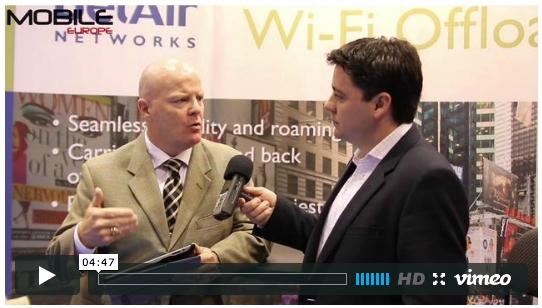There was no newsletter last week as your willing team was in the air returning from 4G World in Chicago, an event that we last visited in 2008 when it was called WiMax World and located in Munich.
This time around, organising company Yankee Group flung some interesting, if tangential, content at the show, with m-payments and Customer Experience Management receiving their day’s workout in pre-conference conferences.
But really the show was all about LTE — from an operator point of view Verizon, Sprint and MetroPCS all expanded on their LTE plan — and it was about small cells and backhaul, with all three being intimately related. One company addressing this confluence was BelAir Networks, fresh from having picked up “silicon valley veteran “ (their words, not mine) Ronny Haraldsvik as its CMO from Byte Mobile.
Now, BelAir has been talking for a while about the need for a pragmatic approach to deploying networks, using the appropriate technology. With this in mind it has produced a combined WiFi, 3G, LTE small cell. Other companies looking at this space were Ruckus Wireless and DragonWave, with the latter launching a product called Avenue that combines space for RAN units plus microwave antennas for backhaul in the same box.
You can hear a little more about BelAir and how it views small cell deployments here. (more of DragonWave later)
BelAir has been running WiFi hotspots for AT&T in the USA, to provide extra capacity in spots of high use. And one notable aspect for a UK visitor to Chicago was the ubiquity of free WiFi. Every bar and restaurant, seemingly, offered free access WiFi. This contrasts to the very patchy situation in the UK, where you may be offered free WiFi, but you are just as likely to run into
So it was interesting, on return this week, to be bade to the centre of London to hear from Nokia about a trial to provide free WiFi “on the streets”. Nokia is sponsoring a project that is seeing Spectrum Interactive, the company that provides WiFi services to BA Lounges, Premier Inns and Travelodge, install WiFi access points on 26 payphone boxes across London.
Nokia hopes to tie this free WiFi provision into usage of its Nokia Maps product so that they can be easily located, and it was easy to see why as a group of journalists, never the most of intuitive of beasts as a collective, meandered around the Oxford Circus area pointing their phones at payphone boxes, hoping to find the Nokia SSID pop up in their WiFi settings. Your brave reporter, having an aversion to wild goose chases, made his excuses and left. But he is reliably informed that a little later the gaggle of tech press did indeed hunt down a working WiFi zone, and managed to authenticate.
So success and kudos, of sorts, to Nokia. Yet this is a small trial, and to provide large scale free WiFi access, even to transient, light users will not come cheaply. The idea is that advertising might make up the shortfall, although you have to doubt the user experience of an ad-supported, drop-in/drop-out WiFi hotspot offering. Operators need not quake yet.
In “different kind of small cells on phone boxes news”, Vodafone confirmed its reputation as the most bullish operator for femtocells, by announcing that it wants more trial sites for the “rural femtocell” trials it is running with Alcatel-Lucent in the UK. The news was appositely timed to coincide with Ofcom figures showing there are still swathes of the country unserved by broadband – many of them rural areas.
If rural femto does work in closing that coverage gap, then you may be looking at increased microwave backhaul investments to follow, given the general lack of fibre to small, rural villages across Europe. Perhaps that lay behind DragonWave’s decision to buy into NSN’s customer channel for microwave. This deal looks like a win for both sides. Nokia gets to offload 300 plus employees, with $10 million worth of liabilities (ie if DragonWave makes them redundant, DragonWave pays, not NSN), DragonWave gets a potential sales pipeline to NSN’s operator customers.
One microwave company we spoke to recently was keen to see its products OEM’d by the likes of and Ericsson (OK, then, it was Siklu). Now here’s another company in the same space buying the appropriate unit of a major NEP to, in effect, secure just such a relationship.
Finally, and stepping away from small cells, a service launch in mobile payments. This launch, called Simply Tap, is designed to let users pay via mobile for items that have a Simply Tap code attached. Users don’t need to scan anything, or swipe an NFC reader, and a code can be attached to a physical or digital item. Some major retailers are on board, and Monitise, which began the week by announcing a hefty strategic investment from Visa Europe, is providing the payments platform.
Although the French operators are doing something similar with Buyster, Simply Tap has pretty much nothing to do with the operators. Distribution is through the app stores; payments technology is provided by Monitise and the banks and card issuers, while uptake is driven by the retailers. It’s not obvious what value operators could add to such an approach, unless direct billing is attractive. NFC, with its security, architecture, distribution challenges, pretty much mandates operator involvement to achieve mass. But approaches like this do not, and that is why delays to NFC roll outs are a strategic threat to the mobile operator.
I’m off now to see if any of the local bars are interested in signing up to Simply [Beer] Tap. Have a good weekend,
Keith Dyer
Webinar now available to view:



